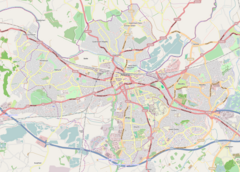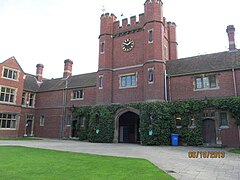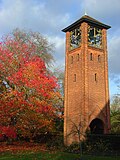
Harwell is a village and civil parish in the Vale of White Horse about 2 miles (3 km) west of Didcot, 6 miles (10 km) east of Wantage and 13 miles (21 km) south of Oxford. The parish measures about 3.5 miles (6 km) north – south, and almost 2 miles (3 km) east – west at its widest point. In 1923 its area was 2,521 acres (1,020 ha). Historically in Berkshire, it has been administered as part of Oxfordshire, England, since the 1974 boundary changes. The parish includes part of the Milton Park business park in the north and part of Harwell Science and Innovation Campus in the southwest. In the east it includes part of the new Great Western Park housing estate that is contiguous with the built-up area of Didcot. The 2011 census recorded the parish's population as 2,349.

In 2011 the Halls of Residence for the University of Exeter in the city of Exeter, Devon, England, have just over 5,000 student residential places, including 3,426 in self-catering purpose-built flats and houses and 1,656 in catered accommodation.

Tabley House is an English country house in Tabley Inferior, some 3 kilometres (1.9 mi) to the west of the town of Knutsford, Cheshire. The house is recorded in the National Heritage List for England as a designated Grade I listed building. It was built between 1761 and 1769 for Sir Peter Byrne Leicester, to replace the nearby Tabley Old Hall, and was designed by John Carr. The Tabley House Collection exists as an exhibition showcased by the University of Manchester.

Eaton Hall, built in 1908 as Eaton Memorial Library, used to be the main library building at Tufts University in Medford, Massachusetts. The historic building was designed by Whitfield & King and donated to the university by Andrew Carnegie. It was one of the first college libraries built with Carnegie funds and is one of the few that never bore his name. Today the building houses departmental offices, classrooms and a computer lab.

Kiplin Hall is a Jacobean historic house at Kiplin in North Yorkshire, England, and a Grade I listed building. It is not far from the River Swale in the Vale of Mowbray. Kiplin Hall is rich in education, in architecture and art, a museum of history, a gallery and provides a biographical record of its past English country house owners. The nearest villages are Scorton, Great Langton and Bolton-on-Swale.

RAF Horsham St Faith is a former Royal Air Force station near Norwich, Norfolk, England which was operational from 1939 to 1963. It was then developed as Norwich International Airport.

Royal Air Force Hemswell or more simply RAF Hemswell is a former Royal Air Force (RAF) station located 7.8 miles (12.6 km) east of Gainsborough, Lincolnshire, England.

Dalton-Ellis Hall is a hall of residence complex at the University of Manchester in Manchester, England. It is situated in the south of the city on Conyngham Road in Victoria Park, next to St Chrysostom's Church. It is close to Wilmslow Road in Rusholme. Dalton-Ellis has 279 male and female residents in catered accommodation. The hall admits both undergraduate and postgraduate students, most are undergraduate first years.

The architecture of Manchester demonstrates a rich variety of architectural styles. The city is a product of the Industrial Revolution and is known as the first modern, industrial city. Manchester is noted for its warehouses, railway viaducts, cotton mills and canals – remnants of its past when the city produced and traded goods. Manchester has minimal Georgian or medieval architecture to speak of and consequently has a vast array of 19th and early 20th-century architecture styles; examples include Palazzo, Neo-Gothic, Venetian Gothic, Edwardian baroque, Art Nouveau, Art Deco and the Neo-Classical.

Matching is a village and civil parish in the Epping Forest district of Essex, England centred in countryside 3 miles (4.8 km) east of Harlow's modern town centre and 2 miles (3.2 km) from Old Harlow/Harlow Mills area of the town. The terrain is elevated and London is centred 21.7 miles (34.9 km) to the south-west.
The Campus of the University of Southern California, also known as the University Park Campus is located in the Exposition Park neighborhood of Los Angeles, California. The campus sprawls across 226 acres and contains most of the academic facilities and residential buildings of the University of Southern California. The University Park campus is in the University Park district of Los Angeles, 2 miles (3.2 km) southwest of downtown Los Angeles. The campus's boundaries are Jefferson Boulevard on the north and northeast, Figueroa Street on the southeast, Exposition Boulevard on the south, and Vermont Avenue on the west. Since the 1960s, through-campus vehicle traffic has been either severely restricted or entirely prohibited on some thoroughfares. The University Park campus is within walking distance to Los Angeles landmarks such as the Shrine Auditorium and Los Angeles Memorial Coliseum, which is operated and managed by the University. Most buildings are in the Romanesque Revival style, although some dormitories, engineering buildings, and physical sciences labs are of various Modernist styles that sharply contrast with the predominantly red-brick campus. Widney Alumni House, built-in 1880, is the oldest university building in Southern California. In recent years the campus has been renovated to remove the vestiges of old roads and replace them with traditional university quads and gardens. The historic portion of the main campus was listed on the National Register of Historic Places in 2015.

Brighton and Hove, a city on the English Channel coast in southeast England, has a large and diverse stock of buildings "unrivalled architecturally" among the country's seaside resorts. The urban area, designated a city in 2000, is made up of the formerly separate towns of Brighton and Hove, nearby villages such as Portslade, Patcham and Rottingdean, and 20th-century estates such as Moulsecoomb and Mile Oak. The conurbation was first united in 1997 as a unitary authority and has a population of about 253,000. About half of the 20,430-acre (8,270 ha) geographical area is classed as built up.

The Pelham Institute is a former working men's club and multipurpose social venue in the Kemptown area of Brighton, part of the English coastal city of Brighton and Hove. Built in 1877 by prolific local architect Thomas Lainson on behalf of the Vicar of Brighton, the multicoloured brick and tile High Victorian Gothic building catered for the social, educational and spiritual needs of the large working-class population in the east of Brighton. After its closure it hosted a judo club, but is now in residential use as flats owned by a housing association. English Heritage has listed the building at Grade II for its architectural and historical importance.

The West Memorial Hall, or West Memorial Institute, is a Victorian Grade II listed building at 7-9 Gosbrook Road, Caversham, Berkshire, designed by Alfred Waterhouse. The Hall is a former Baptist Free Church that has now been converted to apartments.
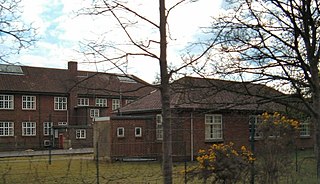
Bordon and Longmoor Military Camps are British Army training camps close to the A3 and A325 roads in and around the settlements of Bordon, Longmoor, Liss and Liphook in Hampshire, England. The main street of the Longmoor part of the camp is built on an ancient Roman road, the Chichester to Silchester Way, while the village of Greatham lies to the west. The combined camp and training area coveres 1,783 hectares of wooded areas, heath, wetlands and hard standings. Longmoor camp and the training areas are still active, and maintained by the Defence Infrastructure Organisation.
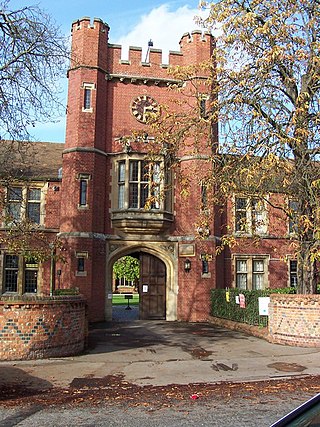
The No 1 School of Military Aeronautics was a World War I training school for the Royal Flying Corps (RFC), based in Reading, England. It was formed in 1915 as an instructors college - but expanded in 1916 into a full RFC training school. In 1917 technical skills were separated and moved to a nearby airfield, Coley Park, as the School of Technical Training. All training at the school was on the ground; ranging from theoretical subjects through to practical training.
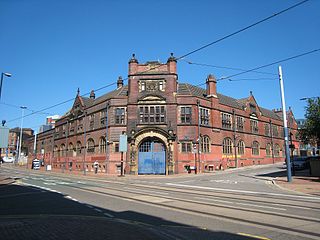
Somme Barracks, Sheffield is a military establishment situated on Glossop Road in Sheffield, England. The building is owned by the Ministry of Defence and serves as the base of the University of Sheffield Officers' Training Corps which is part of the Army Reserve. It is a Grade II listed building.

Bathway Quarter is an area of historic interest in the centre of Woolwich, South East London. Most buildings in the Bathway Quarter are Grade II*, Grade II or locally listed, while the area as a whole is designated a conservation area by Greenwich Council. With the exception of the Old Town Hall, the listed buildings date from the late-19th or early-20th century. Several were designed by local architect Henry Hudson Church, their civic use reflected in their grand elevations formed of red brick with stone detailing.
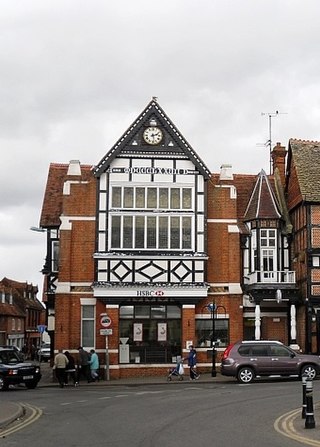
The Old Town Hall is a municipal building in the Market Place in Wantage, Oxfordshire, England. The building, which was the headquarters of Wantage Urban District Council, was converted into apartments in 2018.

